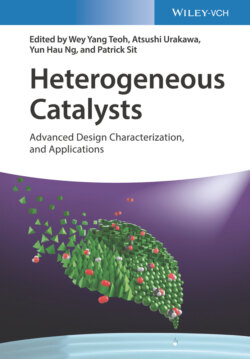Читать книгу Heterogeneous Catalysts - Группа авторов - Страница 35
3.2.1.1 Pulse or Step Anodization
ОглавлениеTo control the growth of internal channel as mentioned above, a number of strategies external to anodization (dominant by lithography‐based method) have been explored. This includes electron beam lithography, focused ion beam lithography, colloid sphere lithography, and direct laser writing lithography. To search within electrochemical means, pulse or step anodization can offer alternative solutions. This approach is built on the understanding that the development of pore channel can be guided by surface texturization at the initial stage of anodization. Periodic nanostructures are known to grow along the internal channel under anodization. When pulse or step is introduced periodically during anodization, acid anions (such as fluoride ions) are intermittently transported or attracted to the layer near the top of pores. Therefore, compensation of such anions would be established from top to the channel bottom in a periodical manner, which results in the morphological variance of the formed anodic oxide thin film. In literature, it is reported that a low frequency voltage (period τ in minutes) permits the growth of bamboo‐type nanotubes and 2D nanolace sheets of alumina [23], while high frequency current oscillation (period τ in seconds) yields the irregular nanoporous morphology. [24] A more advanced anodization setup involving multiple steps has been explored to precisely control pore channels. Although not yet popular, approaches of changing the type of electrolyte (or concentration) after each step, modulating reaction temperature, and varying the applied voltage or current during anodization have also been explored [25–27]. Although overall aim is to achieve rapid reaction to shorten the catalyst preparation time (industrial's preference), an over‐reactive anodization with ultrafast growth rate can cause concerns, i.e. the physical breaking of nanostructures. Debris of nanotubes has been reported physically lying on the thin films due to the breakage. Unwanted delamination of metal oxide nanostructures from the substrate can happen. Therefore, stabilizing the anodization reaction at ultrafast metal oxide growth rate condition is one of the main aspects in improving the method. Depending on the selected catalytic reaction, amorphous or crystalline structure is desired. As‐anodization thin films usually possess lower degree of crystallinity. Additional crystallization process for the anodized thin film is sometimes needed to suit the targeted catalytic reactions.
